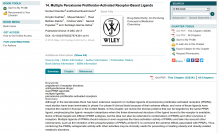Our book chapter about PPARgamma polypharmacology has been just published
Multiple Peroxisome Proliferator-Activated Receptor-Based Ligands. In: Norbert Handler & Helmut Buschmann (eds) Drug Selectivity: An Evolving Concept in Medicinal Chemistry. 2018 Wiley-VCH Verlag GmbH & Co. KGaA
The following book chapter about PPARgamma polypharmacology has been published:
Dmytro Kukhtar, Miquel Mulero, Raul Beltrán-Debón, Cristina Valls, Gerard Pujadas and Santiago Garcia-Vallve. Multiple Peroxisome Proliferator-Activated Receptor-Based Ligands. In: Norbert Handler & Helmut Buschmann (eds) Drug Selectivity: An Evolving Concept in Medicinal Chemistry. Book Series: Methods and Principles in Medicinal Chemistry. 2018 Wiley-VCH Verlag GmbH & Co. KGaA
Summary
Although in the last decades there has been extensive research on multiple ligands of peroxisome proliferator-activated receptors (PPARs); most studies have been terminated in phase II or phase III clinical trials because of their adverse effects, and none of these ligands have reached the market in Europe or the United States. In this chapter, we review the diverse proteins that can be targeted by the same PPAR ligand, emphasizing the ligand-receptor interactions when the three-dimensional structure of the ligand bound to the receptor is available. Some of these targets are different PPAR subtypes, but the idea can also be extended to combinations of PPARs and other enzymes or receptors. Multiple ligands of PPARs should reduce or even suppress the trans-activation activity of PPARγ and take into account other mechanisms, such as the inhibition of the phosphorylation of PPARγ at Ser273, to overcome the adverse effects associated with PPARγ. Thus, combining the PPARγ antagonistic activity with other activities may be clinically useful for preventing or treating obesity and obesity-related metabolic disorders.

